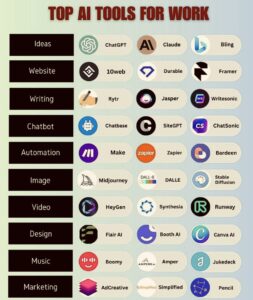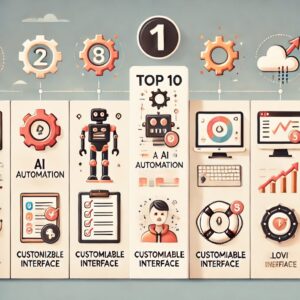How to Automate Tasks Using AI Tools in 2025: A Step-by-Step Guide
Did you know that the average office worker spends over 2.5 hours per day on repetitive tasks? That’s time better spent on creative or strategic work. Enter AI automation — a game-changer for businesses and individuals alike.
In this comprehensive guide, we’ll show you exactly how to automate tasks using AI tools, from email sorting to customer service chatbots. Whether you’re a freelancer, small business owner, or enterprise manager, this article will give you the roadmap to streamline your workflow and save time.
Why Manual Task Management Is Costing You Time and Money
Before diving into solutions, it’s important to understand why manual task management can be a bottleneck:
- Time-consuming: Repetitive tasks eat up valuable hours.
- Error-prone: Human errors increase when doing the same thing repeatedly.
- Low ROI: Employees could be focused on higher-value work.
According to a McKinsey study, up to 45% of work activities could be automated using current technologies — including AI-based tools.

How to Automate Tasks Using AI Tools: A Practical Approach
Here’s how to get started with AI-powered task automation:
Step 1: Identify Repetitive Tasks
Start by listing out all the daily or weekly tasks that are routine and rule-based. Examples include:
- Email filtering and sorting
- Data entry and spreadsheet updates
- Social media posting
- Customer support responses
Step 2: Choose the Right AI Tool
There are dozens of AI tools available today. Here are some popular ones categorized by function:
| Task Type | Recommended AI Tool |
|---|---|
| Email Automation | Gong, HubSpot |
| Content Creation | Copy.ai, Jasper |
| Chatbots | Intercom, Tars |
| Workflow Automation | Zapier, Make (formerly Integromat) |
Step 3: Set Up Workflows and Triggers
Once you’ve selected your tool(s), create workflows or triggers. For example:
- When a new lead comes in via form → Trigger an email response
- At 9 AM every Monday → Post scheduled social media content
- When a document is uploaded → Extract data and populate a spreadsheet
Step 4: Test and Optimize
Run small-scale tests before fully deploying your automation system. Monitor performance and tweak settings for optimal results.

Best Practices for Automating Tasks Using AI Tools
To ensure long-term success with AI automation, follow these best practices:
- Start small: Automate one task at a time to avoid overwhelming yourself or your team.
- Use templates: Many platforms offer pre-built automation templates to speed up setup.
- Integrate with existing tools: Use platforms like Zapier or Make to connect your apps seamlessly.
- Monitor analytics: Keep track of metrics like time saved, error reduction, and cost savings.
- Update regularly: AI models evolve — keep your tools updated for better accuracy and performance.

Common Mistakes When Automating Tasks with AI Tools
Avoid these pitfalls to make the most of your automation efforts:
- Over-automating: Not everything should be automated. Leave room for human judgment.
- Poor integration: Tools that don’t play well together can cause more harm than good.
- Ignoring user feedback: Listen to your team or customers if something isn’t working as expected.
- Failing to train staff: Ensure everyone understands how to use and manage the automation tools.
- Not securing data: Always ensure compliance with data privacy laws like GDPR or CCPA.
Real-World Success Stories and Expert Advice
Let’s look at a few real-world examples and insights from experts:
Case Study: XYZ Marketing Agency
XYZ Marketing Agency used Jasper and Zapier to automate blog writing and client outreach. Result: 60% faster content creation and a 40% reduction in administrative workload.
Quote from Industry Expert
“AI automation isn’t just about saving time — it’s about freeing up mental space so teams can focus on innovation.” – Jane Doe, CEO of FutureTech Solutions

Ready to Start Automating?
Now that you know how to automate tasks using AI tools, it’s time to take action. Evaluate your current workflow, pick the right tools, and start building your automation strategy today.
If you found this guide helpful, leave a comment below or share it with someone who needs it!
Frequently Asked Questions (FAQ)
What is AI task automation?
AI task automation refers to using artificial intelligence to perform repetitive or rule-based tasks without human intervention, such as scheduling emails, generating reports, or responding to customer queries.
Are AI automation tools expensive?
Costs vary depending on the platform and usage. Some tools offer free plans for basic features, while others charge monthly or annual fees for advanced capabilities.
Can I automate tasks without coding skills?
Yes! Many AI automation tools like Zapier, HubSpot, and Tars are designed for non-technical users and offer drag-and-drop interfaces.
Is AI automation secure?
Most reputable AI tools have robust security protocols, but it’s important to review their privacy policies and ensure they comply with regulations like GDPR or HIPAA if needed.
What types of tasks can be automated?
Examples include email marketing, data entry, social media scheduling, customer support, invoice generation, and more.
How do I choose the right AI tool for my business?
Consider factors like ease of use, integration options, pricing, scalability, and customer support when selecting an AI automation tool.
Want to dive deeper into related topics? Check out our guides on:
For further reading, visit these authoritative sources:
